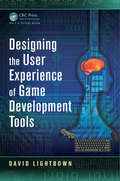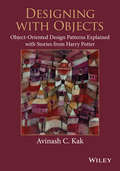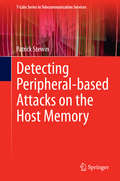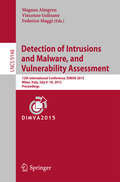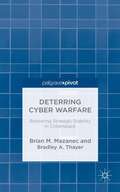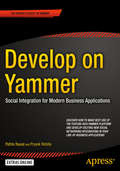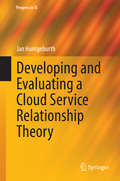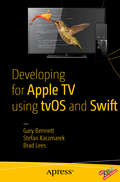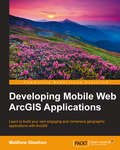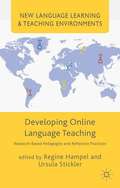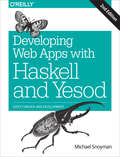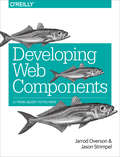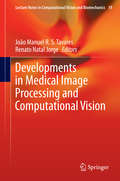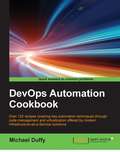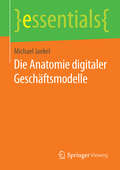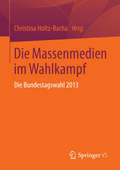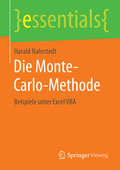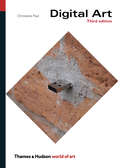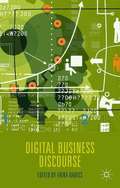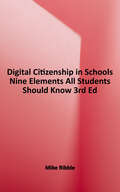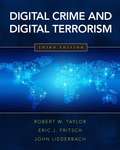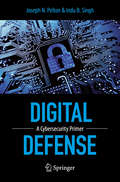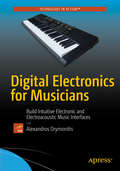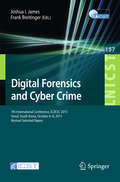- Table View
- List View
Designing the User Experience of Game Development Tools
by David LightbownMost tools developers want to improve the user experience but are not given the time, lack the techniques, or don't know where to begin.Designing the User Experience of Game Development Tools addresses these issues to empower tools developers to make positive steps toward improving the user experience of their tools.The book explains how to im
Designing with Objects
by Avinash C. Kak* All code examples in the book are available for download on a companion site with resources for readers and instructors* A refreshing alternative to the rather abstract and dry explanations of the object-oriented design patterns in much of the existing literature on the subject* In 24 chapters, Designing with Objects explains well-known design patterns by relating them to stories from the Harry Potter series
Detecting Peripheral-based Attacks on the Host Memory
by Patrick StewinThis work addresses stealthy peripheral-based attacks on host computers and presents a new approach to detecting them. Peripherals can be regarded as separate systems that have a dedicated processor and dedicated runtime memory to handle their tasks. The book addresses the problem that peripherals generally communicate with the host via the host's main memory, storing cryptographic keys, passwords, opened files and other sensitive data in the process - an aspect attackers are quick to exploit. Here, stealthy malicious software based on isolated micro-controllers is implemented to conduct an attack analysis, the results of which provide the basis for developing a novel runtime detector. The detector reveals stealthy peripheral-based attacks on the host's main memory by exploiting certain hardware properties, while a permanent and resource-efficient measurement strategy ensures that the detector is also capable of detecting transient attacks, which can otherwise succeed when the applied strategy only measures intermittently. Attackers exploit this strategy by attacking the system in between two measurements and erasing all traces of the attack before the system is measured again.
Detection of Intrusions and Malware, and Vulnerability Assessment
by Magnus Almgren Vincenzo Gulisano Federico MaggiThis book constitutes the refereed proceedings of the 12th International Conference on Detection of Intrusions and Malware, and Vulnerability Assessment, DIMVA 2015, held in Milan, Italy, in July 2015. The 17 revised full papers presented were carefully reviewed and selected from 75 submissions. The papers are organized in topical sections on attacks, attack detection, binary analysis and mobile malware protection, social networks and large-scale attacks, Web and mobile security, and provenance and data sharing.
Deterring Cyber Warfare: Bolstering Strategic Stability in Cyberspace
by Brian M. Mazanec Bradley A. ThayerWhile the deterrence of cyber attacks is one of the most important issues facing the United States and other nations, the application of deterrence theory to the cyber realm is problematic. This study introduces cyber warfare and reviews the challenges associated with deterring cyber attacks, offering key recommendations to aid the deterrence of major cyber attacks.
Develop on Yammer
by Pathik Rawal Pryank RohillaDevelop on Yammer is your guide to integrating the Yammer social network with your company's application ecosystem. By developing custom apps and features on the Yammer platform, you can make your workplace more productive, encourage communication and feedback, and get your colleagues collaborating across a range of platforms, including SharePoint, ASP. NET, and Windows Phone. The book begins with an introduction to the development options available along with guidance on how to set up a Yammer developer account. You'll then take your first step in Yammer integration by building a Yammer feed into a web page or other JavaScript-based client application, before diving into app creation and management on the Yammer platform. The authors provide a deep dive into the Yammer authorization process from client-side and server-side perspectives, and you'll find out how to work closely with Yammer's data streams and its full range of development possibilities using Open Graph and Yammer's REST API. The final chapters cover how to build Yammer integration into standalone applications for SharePoint and Windows Phone 8 with Yammer SDKs. All chapters are illustrated with examples and sample code, and a case study follows the development of a workplace training application as the authors apply each technique, so you can see how to make the most of what Yammer has to offer. What you'll learn Why develop on Yammer, and what development options are available How to add a Yammer feed to an HTML-based application using Yammer Embed, to bring relevant news and discussions into the contexts where they matter How to develop custom Yammer features for your SharePoint, Office or web applications on the client side with the Yammer JavaScript SDK How to carry out secure authorization and authentication on Yammer How to use Yammer Open Graph and REST APIs to posts messages, create custom activities and get data from Yammer-integrated applications How to work with the Yammer Windows Phone 8 SDK to add Yammer functionality to a Windows Phone 8 application Who this book is for This book is targeted at developers with a background in . NET/C# development. Readers should be comfortable working with JavaScript. Software architects will also find this book valuable for planning social integration across their companies' business ecosystems. Table of Contents Chapter 1: Introduction to Yammer Development Chapter 2: Yammer Feed Integration with Yammer Embed Chapter 3: Yammer App Development Basics Chapter 4: Authenticating Your Yammer Users Chapter 5: Writing Data into Yammer with Open Graph Chapter 6: Developing Custom Integrations with the Yammer REST API Chapter 7: Build Social Apps Using Yammer's JavaScript SDK Chapter 8: Build Social Apps Using Yammer's Windows Phone 8 SDK
Developing and Evaluating a Cloud Service Relationship Theory
by Jan HuntgeburthThis book develops, evaluates and refines a cloud service relationship theory that explains how cloud users' uncertainties arise in these relationships and how they can be mitigated. To that end, the book employs principal-agent theory and the concepts of bounded rationality and social embeddedness. Beyond advancing IS research, the findings presented can greatly benefit governments, IT departments and IT providers, helping them to better understand cloud service relationships and to adjust their cloud service strategies accordingly.
Developing for Apple TV using tvOS and Swift
by Gary Bennett Stefan Kaczmarek Brad LeesGary Bennett, Brad Lees, and Stefan Kaczmarek, the team behind Swift 2 for Absolute Beginners, brings you a hands-on "Swift" introduction to the new tvOS SDK with a collection of app projects to try out. You'll learn how to create a BookStore app for the TV, including using Stack Views for book details, how to create a photo gallery app, and how to use collection view and split view controllers with a music collection app. Finally, you'll also learn how to store Apple TV app data in iCloud. The new Apple TV is here, and it's open for your native apps -- Developing for the Apple TV with tvOS and Swift will get you started developing right away. What you'll learn How to use stack views in tvOS How to use collection views and split view controllers How to store Apple TV app data in iCloud How to create native apps for books, photos, and music on the Apple TV Who this book is for Intermediate iOS developers who want to create native Apple TV apps using the new tvOS SDK. Table of Contents Chapter 1: Getting Started with the New Apple TV Chapter 2: The tvOS Weather App Chapter 3: Stack Views and the Focus Engine Chapter 4: Creating a Photo Gallery App Chapter 5: Adding an Album Browser to the Photo Gallery App Chapter 6: Adding a Dynamic Top Shelf to the Photo Gallery App Chapter 7: Storing and Sharing Data Chapter 8: CloudKit
Developing Mobile Web ArcGIS Applications
by Matthew SheehanThis guide is invaluable to those just starting out with GIS development but will also benefit GIS professionals wishing to expand their development skills to include mobile apps.
Developing Online Language Teaching
by Regine HampelWhen moving towards teaching online, teachers are confronted every day with issues such as online moderation, establishing social presence online, transitioning learners to online environments, giving feedback online. This book supports language teaching professionals and researchers who are keen to engage in online teaching and learning.
Developing Web Apps with Haskell and Yesod
by Michael SnoymanThis fast-moving guide introduces web application development with Haskell and Yesod, a potent language/framework combination that supports high-performing applications that are modular, type-safe, and concise. Fully updated for Yesod 1.4, this second edition shows you how Yesod handles widgets, forms, persistence, and RESTful content. Author Michael Snoyman also introduces various Haskell tools to supplement your basic knowledge of the language.By the time you finish this book, you'll create a production-quality web application with Yesod's ready-to-use scaffolding. You'll also examine several real-world examples, including a blog, a wiki, a JSON web service, and a Sphinx search server.Build a simple application to learn Yesod's foundation datatype and Web Application Interface (WAI)Output HTML, CSS, and Javascript with Shakespearean template languagesGet an indepth look at Yesod's core monads for producing cleaner, more modular codeProbe Yesod's internal workings: learn the request handling process for a typical applicationBuild forms on top of widgets by implementing the yesod-form declarative APILearn how Yesod and Haskell handle persistence and session dataServe an HTML page and a machine-friendly JSON page from the same URL
Developing Web Components
by Jason Strimpel Jarrod OversonAlthough web components are still on the bleeding edge--barely supported in modern browsers--the technology is also moving extremely fast. This practical guide gets you up to speed on the concepts underlying W3C's emerging standard and shows you how to build custom, reusable HTML5 Web Components.Regardless of your experience with libraries such as jQuery and Polymer, this book teaches JavaScript developers the DOM manipulations these libraries perform. You'll learn how to build a basic widget with vanilla JavaScript and then convert it into a web component that's semantic, declarative, encapsulated, consumable, and maintainable. With custom components, the Web can finally fulfill its potential as a natively extensible application platform. This book gets you in at the right time.Understand core concepts (such as normal flow and positioning, and Z-index) for properly positioning, dragging, and resizing elementsExplore UI concepts and patterns typically abstracted away by Dojo, jQuery UI, Kendo UI, and other librariesDive into the W3C standard and convert your working widget example into a fully functioning web componentLearn how to encapsulate, package, and deploy your web components with Google's Polymer framework
Developments in Medical Image Processing and Computational Vision
by João Manuel R. S. Tavares Renato Natal JorgeThis book presents novel and advanced topics in Medical Image Processing and Computational Vision in order to solidify knowledge in the related fields and define their key stakeholders. It contains extended versions of selected papers presented in VipIMAGE 2013 - IV International ECCOMAS Thematic Conference on Computational Vision and Medical Image, which took place in Funchal, Madeira, Portugal, 14-16 October 2013. The twenty-two chapters were written by invited experts of international recognition and address important issues in medical image processing and computational vision, including: 3D vision, 3D visualization, colour quantisation, continuum mechanics, data fusion, data mining, face recognition, GPU parallelisation, image acquisition and reconstruction, image and video analysis, image clustering, image registration, image restoring, image segmentation, machine learning, modelling and simulation, object detection, object recognition, object tracking, optical flow, pattern recognition, pose estimation, and texture analysis. Different applications are addressed and described throughout the book, comprising: biomechanical studies, bio-structure modelling and simulation, bone characterization, cell tracking, computer-aided diagnosis, dental imaging, face recognition, hand gestures detection and recognition, human motion analysis, human-computer interaction, image and video understanding, image processing, image segmentation, object and scene reconstruction, object recognition and tracking, remote robot control, and surgery planning. This volume is of use to researchers, students, practitioners and manufacturers from several multidisciplinary fields, such as artificial intelligence, bioengineering, biology, biomechanics, computational mechanics, computational vision, computer graphics, computer science, computer vision, human motion, imagiology, machine learning, machine vision, mathematics, medical image, medicine, pattern recognition, and physics.
DevOps Automation Cookbook
by Michael DuffyOver 120 recipes covering key automation techniques through code management and virtualization offered by modern Infrastructure as a Service About This Book * Use some of the powerful tools that have emerged to enable systems administrators and developers to take control and automate the management, monitoring, and creation of complex infrastructures * Covers some of the most exciting technologies available to DevOps engineers, and demonstrates multiple techniques for using them * A hands-on guide filled with clear examples and multiple methodologies to demonstrate the various DevOps tools available Who This Book Is For If you are a systems administrator or developer who is keen to employ DevOps techniques to help with the day-to-day complications of managing complex infrastructures, then this book is for you. No prior knowledge of DevOps tools is required. What You Will Learn * Manage, use, and work with code in the Git version management system * Manage the life cycle of hosts, from creation to on-going management, using Puppet Razor * Create hosts automatically using a simple combination of TFTP, DHCP, and pre-seeds * Implement virtual hosts using the ubiquitous VMware ESXi hypervisor * Control configuration using the powerful and popular Ansible configuration management system * Develop powerful, consistent, and portable containers using Docker * Track trends, discover data, and monitor key systems using InfluxDB, syslog, and Sensu * Deal efficiently with powerful cloud infrastructures using the Amazon AWS Infrastructure as a Service and the Heroku Platform as a Service In Detail There has been a recent explosion in tools that allow you to redefine the delivery of infrastructure and applications, using a combination of automation and testing to deliver continuous deployment. DevOps has garnered interest from every quarter, and is rapidly being recognized as a radical shift, as large as the Agile movement for the delivery of software. This book takes a collection of some of the coolest software available today and shows you how to use it to create impressive changes to the way you deliver applications and software. It tackles the plethora of tools that are now available to enable organizations to take advantage of the automation, monitoring, and configuration management techniques that define a DevOps-driven infrastructure. Starting off with the fundamental command-line tools that every DevOps enthusiast must know, this book will guide you through the implementation of the Ansible tool to help you facilitate automation and perform diverse tasks. You will explore how to build hosts automatically with the creation of Apt mirrors and interactive pre-seeds, which are of the utmost importance for Ubuntu automation. You will also delve into the concept of virtualization and creating and manipulating guests with ESXi. Following this, you will venture into the application of Docker; learn how to install, run, network, and restore Docker containers; and also learn how to build containers in Jenkins and deploy apps using a combination of Ansible, Docker, and Jenkins. You will also discover how to filter data with Grafana and the usage of InfluxDB along with unconventional log management. Finally, you will get acquainted with cloud infrastructure, employing the Heroku and Amazon AWS platforms. By tackling real-world issues, this book will guide you through a huge variety of tools, giving new users the ability to get up and running and offering advanced users some interesting recipes that may help with existing issues. Style and approach This book has an easy-to-follow approach to both introducing the wide range of available DevOps tools and working with them. Each recipe is lavishly sprinkled with example code and uses clear instructions to easily allow you to see how you can both implement the solutions, and more importantly, tailor them to your unique needs.
Die Anatomie digitaler Geschäftsmodelle (essentials)
by Michael JaekelDieses essential bietet eine Einführung in das Thema digitale Geschäftsmodelle. Es zielt insbesondere darauf ab, ihr Wesen verständlich zu machen, und zeigt ihre Ausgestaltung anhand von Beispielen. Die zunehmende Digitalisierung nahezu aller Lebensbereiche hat gravierende Auswirkungen auf bestehende Geschäftsmodelle in zahlreichen Branchen. Daher ist ein besseres Verständnis digitaler Geschäftsmodelle dringend erforderlich. Michael Jaekel erläutert das innere Gefüge, die Anatomie digitaler Geschäftsmodelle. Hinzu kommen Anregungen und Prinzipien für ihr Design. Die Ausführungen erfolgen nicht abstrakt, sondern praxisorientiert am Modell einer digitalen Smart-City-Apps-Plattform mit Ökosystem.
Die Massenmedien im Wahlkampf
by Christina Holtz-BachaNoch während der Bundestagswahlkampf 2013 im Gange war, wurde er verschiedentlich als flau beurteilt. Die Kampagne ließ Highlights und Innovationen vermissen. Die Forschung zur Wahlkampfkommunikation gewinnt daher ihren Wert vor allem in der Langzeitperspektive, die es möglich macht zu prüfen, ob die oftmals diagnostizierten Trends moderner Kampagnen wie Professionalisierung und Personalisierung zutreffen und ob Verschiebungen in der Rolle und der Bedeutung der klassischen Medien auf der einen und Internet sowie sozialen Netzwerken auf der anderen Seite eintreten. Die Beiträge dieses Bandes analysieren die verschiedenen Mittel der Kampagnenkommunikation, die Berichterstattung der Medien und untersuchen Wirkungsfragen.
Die Monte-Carlo-Methode: Beispiele unter Excel VBA (essentials)
by Harald NahrstedtHarald Nahrstedt zeigt hier den pragmatisch technischen und weniger den wissenschaftlichen Ansatz, wie Excel mit seinen Programmiermöglichkeiten sich immer mehr zu einem universellen Arbeitsmittel entwickelt. So ist die Simulation mit Hilfe von Pseudozufallszahlen ein schneller und preiswerter Weg zu fachlichen Aussagen. Den Rahmen dieser Abhandlung bildet der geschichtliche Hintergrund.
Digital Art (Third edition) (World of Art)
by Christiane Paul"Paul does an impressive job of compressing the activity of a huge field, in which there are no obvious heroes and no single aesthetic line." --Publishers Weekly Digital technology has revolutionized the way we produce and experience art today. Not only have traditional forms of art such as printing, painting, photography, and sculpture been transformed by digital techniques and media, but the emergence of entirely new forms such as internet and software art, digital installation, and virtual reality has forever changed the way we define art. Christiane Paul surveys the developments in digital art from its appearance in the 1980s to the present day and looks ahead to what the future may hold. She discusses the key artists and works in the genre, drawing a distinction between work that uses digital practices as tools to produce traditional forms and work that uses them to create new kinds of art. She explores the broader themes and questions raised by these artworks such as viewer interaction, artificial life and intelligence, political and social activism, networks and telepresence, and issues surrounding the collection, presentation, and preservation of digital art. This third, expanded edition of the popular resource investigates key areas of digital art practice that have gained prominence in recent years, including interactive public installation, augmented and mixed reality, social networking, and file-sharing technologies.
Digital Business Discourse
by Erika DaricsDigital Business Discourse offers a distinctively language- and discourse-centered approach to digitally mediated business and professional communication, providing a timely and comprehensive assessment of the current digital communication practices of today's organisations and workplaces. It is the first dedicated publication to address how computer-mediated communication technologies affect institutional discourse practices, bringing together scholarship from a range of disciplinary backgrounds, including organisational and management studies, rhetorical and communication studies, communication training and discourse analysis. Covering a wide spectrum of communication technologies, such as email, instant messaging, message boards, Twitter, corporate blogs and consumer reviews, the chapters gather research drawing on empirical data from real professional contexts. In this way, the book contributes to both academic scholarship and business communication training, enabling researchers, trainers and practitioners to deepen their understanding of the impact of new communication technologies on professional and corporate communication practices.
Digital Citizenship in Schools: Nine Elements Students Should Know
by Mike RibbleDigital Citizenship in Schools, third Edition is an essential introduction to digital citizenship. Starting with a basic definition of the concept and an explanation of its relevance and importance, author Mike Ribble goes on to explore the nine elements of digital citizenship. He provides useful audit and professional development activities to help educators determine how to go about integrating digital citizenship concepts into the classroom. Activity ideas and lesson plans round out this timely book.
Digital Crime and Digital Terrorism (3rd Edition)
by John Liederbach Robert W. Taylor Eric J. FritschThis book focuses on both the technical aspects of digital crime as well as behavioral aspects of computer hackers, virus writers, terrorists and other offenders. Using real life examples and case studies, the book examines the history, development, extent and types of digital crime and digital terrorism as well as current legislation and law enforcement practices designed to prevent, investigate and prosecute these crimes. For professionals in the technical field as well as forensic investigators and other criminal justice professionals.
Digital Defense
by Joseph N. Pelton Indu B. SinghDrs. Pelton and Singh warn of the increasing risks of cybercrime and lay out a series of commonsense precautions to guard against individual security breaches. This guide clearly explains the technology at issue, the points of weakness and the best ways to proactively monitor and maintain the integrity of individual networks. Covering both the most common personal attacks of identity fraud, phishing, malware and breach of access as well as the larger threats against companies and governmental systems, the authors explain the vulnerabilities of the internet age. As more and more of life's transactions take place online, the average computer user and society at large have a lot to lose. All users can take steps to secure their information. Cybercrime is so subtle and hidden, people can ignore the threat until it is too late. Yet today about every three seconds a person is hit by some form of cyber attack out of the blue. Locking the "cyber-barn door" after a hacker has struck is way too late. Cyber security, cyber crime and cyber terrorism may seem to be intellectual crimes that don't really touch the average person, but the threat is real. Demystifying them is the most important step and this accessible explanation covers all the bases.
Digital Design using VHDL: A Systems Approach
by William J. Dally R. Curtis Harting Tor M. AamodtThis introductory textbook provides students with a system-level perspective and the tools they need to understand, analyze and design digital systems. Going beyond the design of simple combinational and sequential modules, it shows how such modules are used to build complete systems, reflecting real-world digital design. All the essential topics are covered, including design and analysis of combinational and sequential modules, as well as system timing and synchronization. It also teaches how to write VHDL-2008 HDL in a productive and maintainable style that enables CAD tools to do much of the tedious work. A complete introduction to digital design is given through clear explanations, extensive examples and online VHDL files. The teaching package is completed with lecture slides, labs and a solutions manual for instructors. Assuming no previous digital knowledge, this textbook is ideal for undergraduate digital design courses that will prepare students for modern digital practice.
Digital Electronics for Musicians
by Alexandros DrymonitisDigital Electronics for Musicians is the perfect book for musicians who want to dive into the world of computer music and physical computing. This book is aimed at adventurous musicians who want to learn about music programming with Arduino, sensors, and Pure Data, and how to make new interfaces and even new instruments with that knowledge. You'll learn the basics of the Pure Data and Arduino languages, how to incorporate sensors into your musical projects, and how to use embedded computers, like the Raspberry Pi, to create stand-alone projects. Along the way, you'll learn how to create a variety of innovative (Mark, Michelle, I guess they are innovative, but not 100% sure) musical projects, including an interactive bow for stringed instruments, a MIDI clavier synthesizer, an interactive drum set, a patch-bay matrix synthesizer, a guitar looper, and even a DIY theremin. If you are a musician or tinkerer who wants to explore the world of electronic and electroacoustic music and musical interfaces with Arduino, sensors, and Pure Data, Digital Electronics for Musicians is the book for you. What you'll learn Learn the basics of the Pure Data and the Arduino languages Learn more about the available sensors on the market, and how you can incorporate them into your musical projects Focus on physical computing by combining Arduino and Pure Data, bringing the physical world to the world of the computers Make use of additional libraries that extend the capabilities of the Arduino Make use of external objects in Pure Data that help achieve certain goals, depending on the project Learn how a Pure Data patch functions and be able to modify other people's work that fits your needs Learn how the Arduino language works, enabling the modification of already existing code, according to your needs Get insight on the serial communication between the Arduino and Pure Data Learn how to approach various programming challenges in different ways Who this book is for Musicians who want to explore the world of electronic and electroacoustic music and musical interfaces with Arduino, sensors, and Pure Data. Table of Contents Chapter 1: Introduction to Pure Data Chapter 2: Intro to Arduino Chapter 3: Embedded computers and going wireless Chapter 4: Getting started with musical applications Chapter 5: A simple synthesizer using a MIDI keyboard and Arduino Chapter 6: An interactive bow Chapter 7: An interactive drum set Chapter 8: A DIY Theremin Chapter 9: Making a looper Chapter 10: A patch-bay matrix synthesizer
Digital Forensics and Cyber Crime
by Joshua I. James Frank BreitingerThis book constitutes the refereed proceedings of the 7th International Conference on Digital Forensics and Cyber Crime, ICDF2C 2015, held in Seoul, South Korea, in October 2015. The 14 papers and 3 abstracts were selected from 40 submissions and cover diverse topics ranging from tactics of cyber crime investigations to digital forensic education, network forensics, and international cooperation in digital investigations.
